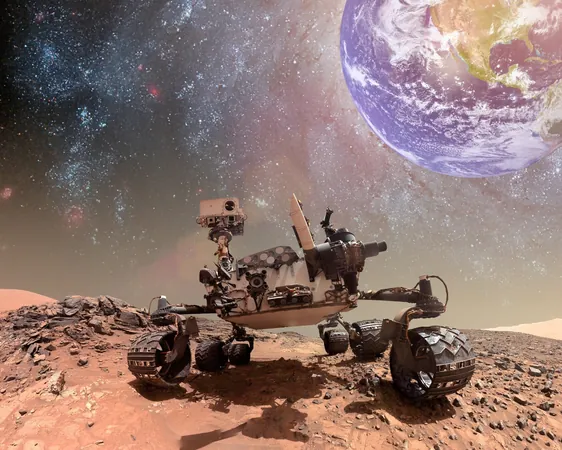
Curiosity Rover Caught in Action: A Stunning First for Mars Exploration
2025-04-27
Author: Wai
NASA's Curiosity Mars rover has always dazzled us with its photographic prowess, from breathtaking selfies to stunning space imagery. But on February 28, during its 4,466th Martian day—known as sol—Curiosity made history by being photographed mid-drive by one of NASA's orbiting cameras.
A Rare Glimpse at Curiosity in Motion
Captured by the HiRISE (High-Resolution Imaging Science Experiment) camera aboard NASA’s Mars Reconnaissance Orbiter, the image reveals Curiosity as a speck racing across the Red Planet’s surface, leaving a trail of tracks that spans about 1,050 feet (320 meters) from its recent excursions.
Curiosity's Purpose: More Than Just Beautiful Views
Launched in 2012 with a spectacular landing, Curiosity wasn't designed merely for scenic shots. Its mission is pivotal: to discover if Mars ever had the conditions suitable for life. Exploring the ancient Gale Crater, Curiosity drills into rocks, analyzes soil, and studies the Martian climate and geology.
Every finding contributes to a deeper understanding of Mars's past, revealing evidence of ancient rivers and lakes, which are crucial indicators of the planet's potential to support life.
Navigating the Martian Landscape
Curiosity’s path isn’t predetermined; it faces challenges based on its navigation system and the rugged terrain. Engineers from NASA’s Jet Propulsion Laboratory collaborate closely with scientists each day for precise maneuvering.
Doug Ellison, Curiosity's planning team chief at JPL, explained that by synchronizing the time HiRISE took the image with the rover’s commands, they confirmed Curiosity was nearing the end of a 69-foot (21-meter) drive.
What Do the Tracks Reveal?
In the latest snapshot, Curiosity's tracks lead to a steep slope it has since climbed, with expectations to reach its next scientific site within a month. These tracks may remain etched in the Martian surface for quite some time—unless the winds decide to erase them.
The Bigger Picture of Mars Exploration
Curiosity’s ongoing journey is just one facet of a broader vision for Mars exploration. NASA and other agencies are strategizing future missions based on lessons learned from current explorations. Missions like Perseverance are already in progress, collecting rock samples that could one day return to Earth for comprehensive analysis.
Plans for the 2030s include launching more advanced equipment, executing complex sample returns, and even sending astronauts to Mars—a dream once seen as purely fantastical.
Each of Curiosity's discoveries helps ward off the monotony of the alien landscape, laying a strong foundation for these ambitious future missions. It reminds humanity that even the meticulous journey of a single rover can ignite dreams far beyond Earth.


 Brasil (PT)
Brasil (PT)
 Canada (EN)
Canada (EN)
 Chile (ES)
Chile (ES)
 Česko (CS)
Česko (CS)
 대한민국 (KO)
대한민국 (KO)
 España (ES)
España (ES)
 France (FR)
France (FR)
 Hong Kong (EN)
Hong Kong (EN)
 Italia (IT)
Italia (IT)
 日本 (JA)
日本 (JA)
 Magyarország (HU)
Magyarország (HU)
 Norge (NO)
Norge (NO)
 Polska (PL)
Polska (PL)
 Schweiz (DE)
Schweiz (DE)
 Singapore (EN)
Singapore (EN)
 Sverige (SV)
Sverige (SV)
 Suomi (FI)
Suomi (FI)
 Türkiye (TR)
Türkiye (TR)
 الإمارات العربية المتحدة (AR)
الإمارات العربية المتحدة (AR)